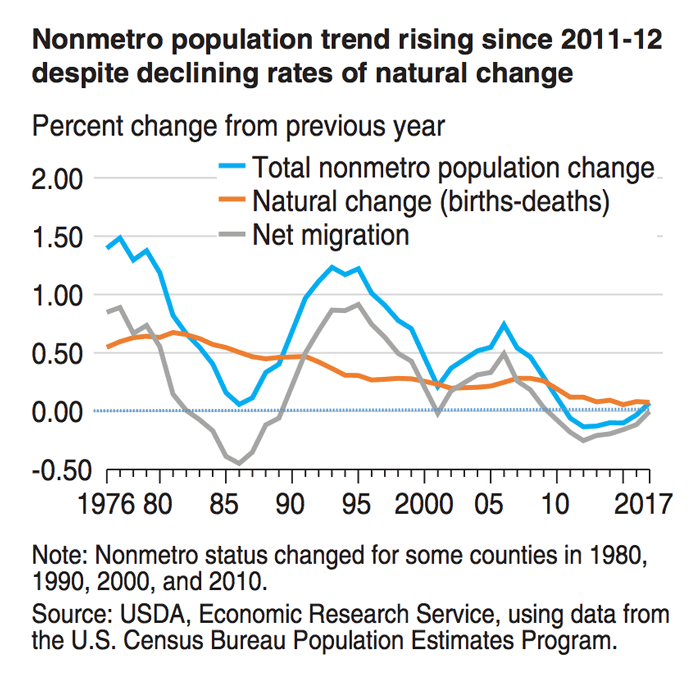USDA 2018 report on Rural America notes the steady increase of rural populations following years of declines. In the report, the USDA looks at net migration, population trends and employment growth.
The decline in rural population, which began in 2010 and reached its lowest level in 2011-12 with a loss of nearly 62,000 residents, has since begun to reverse.1 In 2016-17, rural counties added population for the first time this decade. The recent upturn in rural population comes from increasing rates of net migration as opposed to natural change (births minus deaths). Increased net migration has coincided with declining rural unemployment, rising incomes, and declining poverty since 2013. However, national population trends mask variation at the local level, where changing population directly impacts rural well-being and economic development prospects. Rural population trends between 2012-13 and 2016-17 also varied considerably by race/ethnicity.
Since peaking at 10.3% in 2010, the rural unemployment rate steadily declined to 4.4% in 2017; urban areas followed suit, with unemployment dropping from 9.9 to 4.1%. Declining unemployment rates and a small increase in population ages 16 and older corresponded to the addition of more than 650,000 jobs in rural counties between 2013 and 2017. At the same time, falling labor force participation (due primarily to an aging population among non-Hispanic Whites) corresponded to a decline in employment of nearly 280,000, leaving a net increase in jobs of roughly 370,000. After peaking in 2013, rural poverty rates decreased across all racial and ethnic groups, although they continue to be significantly higher among racial/ethnic groups other than non-Hispanic Whites.
The graying of rural areas continues as they attract retirees and lose new labor force entrants. The vast majority of “older-age counties”—with more than 20% of their population age 65 and older—are in rural areas. Rural counties become older by attracting retirees in search of scenic or lifestyle amenities or by losing young adults to outmigration. These demographic processes can lead to similar age profiles statistically, but are happening in different places and under different economic circumstances.
To read the full report, click here.
1 Rural areas are defined here using nonmetropolitan (nonmetro) counties. The terms “rural” and “nonmetro” are used interchangeably as are “urban” and “metro.” Statistics are calculated using the 2013 nonmetro definition. For more on these definitions, visit the ERS “What Is Rural?” topic page.





Post a comment
Report Abusive Comment